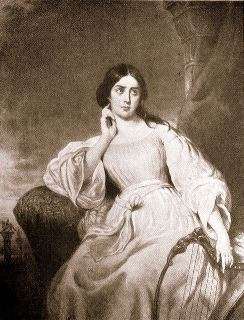|
Back
The Art of the Diva New York
The Sam, Flea Theater
05/03/2019 -
“Leading Ladies Liberated”
Gioachino Rossini: Otello: “Assisa a un pie d’un salice” [1]
Wolfgang Amadeus Mozart: Così fan tutte, K. 588: “Temerari!... Come scoglio” [4]
Vincenzo Bellini: Capuleti e Montecchi: “Oh! Quante volte” [3]
Gaetano Donizetti: Maria Stuarda: “O nube! Che lieve per l’aria ti aggiri” [2]
Isabella Colbran: Six Petits Airs italiens [1]
María Malibran: Il mattino [3]
Pauline Viardot-García: Poem [2] – Cendrillon (excerpts)
Lily Arbisser (Cendrillon) [1], Samina Aslam (Maguelonne) [2], Eugenia Forteza (La Fée) [3], Nicole Leone (Armalinde) [4] (sopranos), Eric Sedgwick (piano)
Nicole Leone, Randi Marazzo (Artistic Directors), Victor Khodada (Cendrillon Stage Director)

Henri Decaisne: María Malibran as Desdemona (1830)
Colbran, Malibran and Viardot-García were famous opera singers during the early to mid-19th century in Europe. They were famous as performers of Rossini, Donizetti and Bellini. All three also composed art songs. Viardot even composed opera.
This evening featured not only the songs for which these singers became famous, but also their own compositions, which are seldom heard and deserving of performance. The Modern Reveal and New Camerata Opera remind us of the glorious times of the diva, but also of their wide-ranging style embracing competence, including composition. In our day, Renee Fleming is an actress and Barbara Hannigan, a conductor. (One suspects that she could compose if she chose to.)
Isabella Colbran was married to Gioachino Rossini. Colbran’s connection to royalty kept her off the stage in Naples, the home town of her husband. Rossini wrote many leading lady roles for her before her voice started to go and they divorced.
Malibran and her sister, Pauline Viardot-García were daughters of a famed Italian tenor, teacher and impresario, Manuel García. Malibran by nature astonished. For her sister, the voice was a rebel to pursue not a vessel to command. Malibran was born to the role. Viardot worked for her sumptuous presence.
Malibran, diva of all divas, cast her reflection on Venetian canals as she was polled about and remarked that the canals would never be the same. She once picked up a bouquet of flowers thrown on the stage for Henriette Sontag, her partner in singing that evening. A voice from the balcony cried out, “That is not for you.” Malibran replied, “I wanted to give it to her myself.”
Malibran was the first singer to bring drama to the musical line. She was naturally a mezzo, but for performance purposes trained her voice through discipline and sheer nerve to reach upper registers. She became one with her music. As Desdemona, Malibran tore around the stage escaping from Otello, who she was sure would kill her. Lily Arbisser, in a lovely light but pleasantly piercing soprano, inflected her Desdemona tones with both beauty and fear.
Malibran was the first singer to throw her all at the roles she sang. She in fact sang herself to death. Choosing to ride a beautiful but untamed horse in Manchester, she was thrown from the saddle, one foot stuck in a stirrup and dragged along before she could be rescued. This effectively ended her career and her life. She would say of less successful singers that they had not suffered enough. This surely was not Malibran's problem.
Her sister Viardot was more sensitive than sensational, and had a surpassing imagination and intelligence. Nicole Leone sang a Fiordiligi aria from Così fan tutte. Mozart, of course, was the foundation of all opera companies in the early to mid-nineteenth entry. Viardot is known to have sung parts of the opera, but never apparently sang the entire work.
Eugenia Forteza performed from Bellini’s I Capuleti e Montecchi, which both García sisters had sung often. Samina Aslam displayed that same rich mezzo which could echo to the heavens and characterized Malibran’s voice. Donizetti wrote Maria Stuarda for her. This juicy, desperate role was perfect for Aslam’s rich voice.
Compositions by Colbran were sung by Lily Arbisser. Eugenia Forteza sang María Malibran’s music and Samina Aslam gave us Viardot, who lived a long life and composed often.
We had a sampling of delightful scenes from Viardot’s Cendrillon in which all the divas sang beautifully together. The evening made one yearn for the return of the diva to the opera stage. Trails of chiffon hung from the ceiling across the stage. The singers often wrapped themselves in the frothy material as they sang. Camp was clearly part of their performance when humor was required. These young divas clearly appreciate the art of the diva and revived it for a moment in New York.
Susan Hall
|